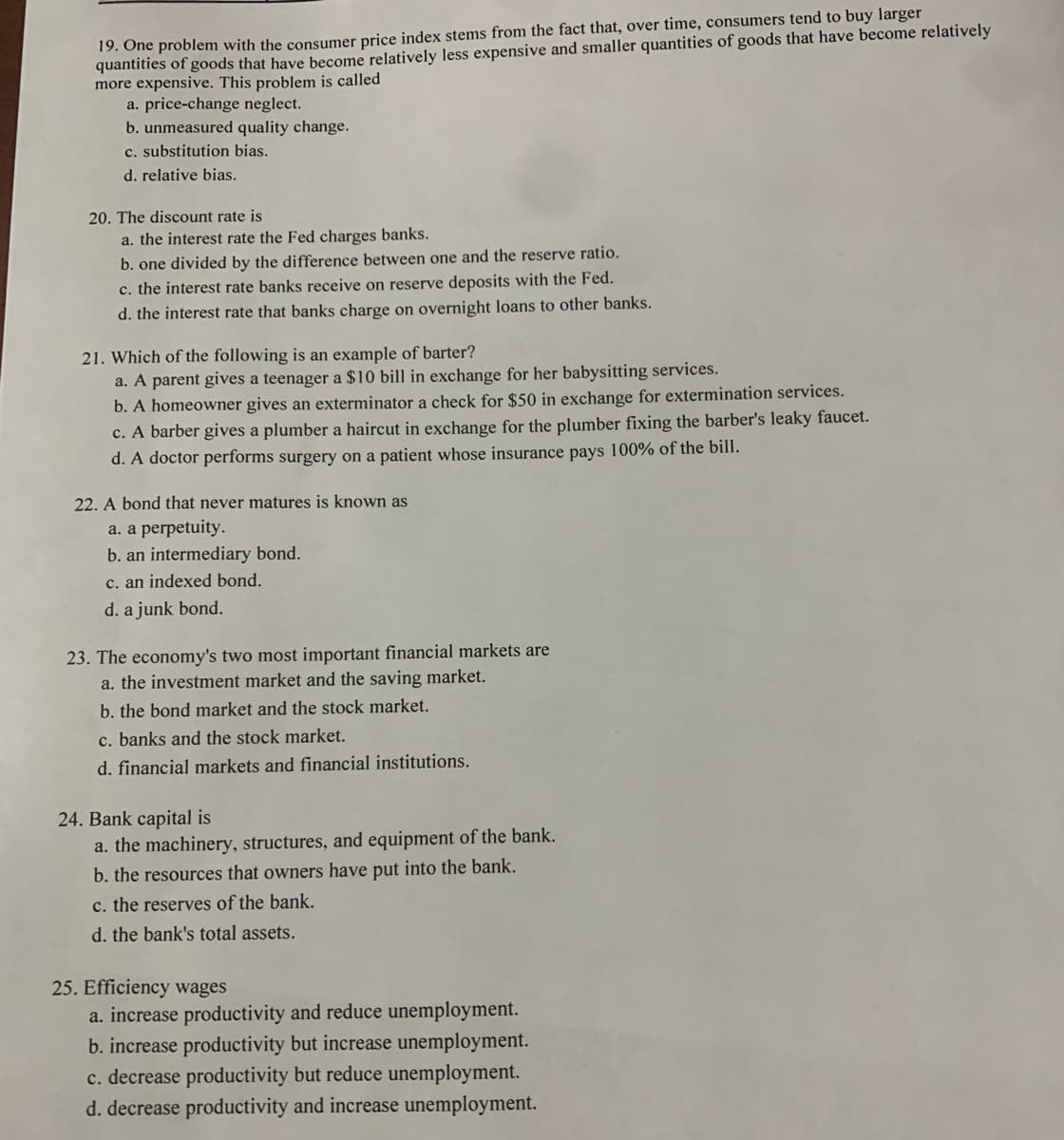19. One problem with the consumer price index stems from the fact that, over time, consumers tend to Buy quantities of goods that have become relatively less expensive and smaller quantities of goods that have become relatively more expensive. This problem is called a. price-change neglect. b. unmeasured quality change. c. substitution bias. d. relative bias.
19. One problem with the consumer price index stems from the fact that, over time, consumers tend to Buy quantities of goods that have become relatively less expensive and smaller quantities of goods that have become relatively more expensive. This problem is called a. price-change neglect. b. unmeasured quality change. c. substitution bias. d. relative bias.
Principles of Economics (MindTap Course List)
8th Edition
ISBN:9781305585126
Author:N. Gregory Mankiw
Publisher:N. Gregory Mankiw
Chapter36: Six Debates Over Macroeconomic Policy
Section: Chapter Questions
Problem 3PA
Related questions
Question

Transcribed Image Text:19. One problem with the consumer price index stems from the fact that, over time, consumers tend to buy larger
quantities of goods that have become relatively less expensive and smaller quantities of goods that have become relatively
more expensive. This problem is called
a. price-change neglect.
b. unmeasured quality change.
c. substitution bias.
d. relative bias.
20. The discount rate is
a. the interest rate the Fed charges banks.
b. one divided by the difference between one and the reserve ratio.
c. the interest rate banks receive on reserve deposits with the Fed.
d. the interest rate that banks charge on overnight loans to other banks.
21. Which of the following is an example of barter?
a. A parent gives a teenager a $10 bill in exchange for her babysitting services.
b. A homeowner gives an exterminator a check for $50 in exchange for extermination services.
c. A barber gives a plumber a haircut in exchange for the plumber fixing the barber's leaky faucet.
d. A doctor performs surgery on a patient whose insurance pays 100% of the bill.
22. A bond that never matures is known as
a. a perpetuity.
b. an intermediary bond.
c. an indexed bond.
d. a junk bond.
23. The economy's two most important financial markets are
a. the investment market and the saving market.
b. the bond market and the stock market.
c. banks and the stock market.
d. financial markets and financial institutions.
24. Bank capital is
a. the machinery, structures, and equipment of the bank.
b. the resources that owners have put into the bank.
c. the reserves of the bank.
d. the bank's total assets.
25. Efficiency wages
a. increase productivity and reduce unemployment.
b. increase productivity but increase unemployment.
c. decrease productivity but reduce unemployment.
d. decrease productivity and increase unemployment.
Expert Solution
Trending now
This is a popular solution!
Step by step
Solved in 9 steps with 9 images

Knowledge Booster
Learn more about
Need a deep-dive on the concept behind this application? Look no further. Learn more about this topic, economics and related others by exploring similar questions and additional content below.Recommended textbooks for you

Principles of Economics (MindTap Course List)
Economics
ISBN:
9781305585126
Author:
N. Gregory Mankiw
Publisher:
Cengage Learning

Brief Principles of Macroeconomics (MindTap Cours…
Economics
ISBN:
9781337091985
Author:
N. Gregory Mankiw
Publisher:
Cengage Learning

Principles of Macroeconomics (MindTap Course List)
Economics
ISBN:
9781305971509
Author:
N. Gregory Mankiw
Publisher:
Cengage Learning

Principles of Economics (MindTap Course List)
Economics
ISBN:
9781305585126
Author:
N. Gregory Mankiw
Publisher:
Cengage Learning

Brief Principles of Macroeconomics (MindTap Cours…
Economics
ISBN:
9781337091985
Author:
N. Gregory Mankiw
Publisher:
Cengage Learning

Principles of Macroeconomics (MindTap Course List)
Economics
ISBN:
9781305971509
Author:
N. Gregory Mankiw
Publisher:
Cengage Learning

Principles of Economics, 7th Edition (MindTap Cou…
Economics
ISBN:
9781285165875
Author:
N. Gregory Mankiw
Publisher:
Cengage Learning

Principles of Macroeconomics (MindTap Course List)
Economics
ISBN:
9781285165912
Author:
N. Gregory Mankiw
Publisher:
Cengage Learning

Essentials of Economics (MindTap Course List)
Economics
ISBN:
9781337091992
Author:
N. Gregory Mankiw
Publisher:
Cengage Learning